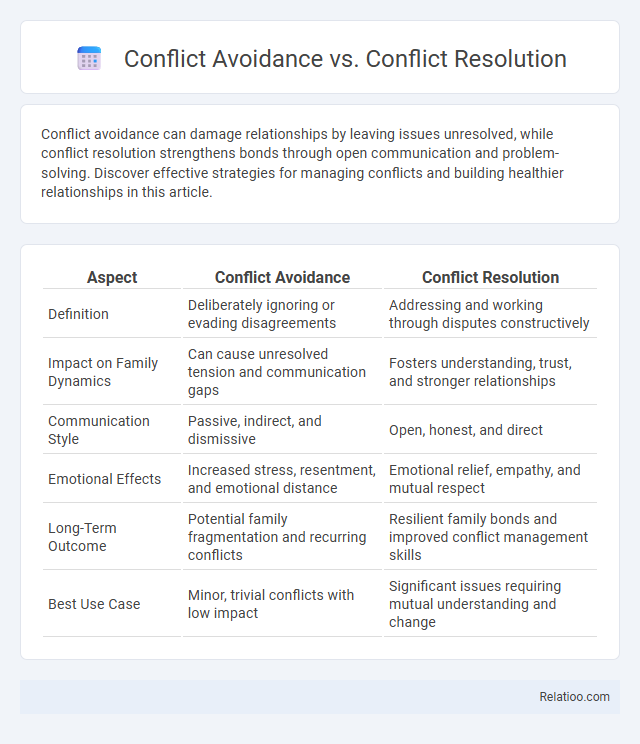Conflict avoidance can damage relationships by leaving issues unresolved, while conflict resolution strengthens bonds through open communication and problem-solving. Discover effective strategies for managing conflicts and building healthier relationships in this article.
Table of Comparison
| Aspect | Conflict Avoidance | Conflict Resolution |
|---|---|---|
| Definition | Deliberately ignoring or evading disagreements | Addressing and working through disputes constructively |
| Impact on Family Dynamics | Can cause unresolved tension and communication gaps | Fosters understanding, trust, and stronger relationships |
| Communication Style | Passive, indirect, and dismissive | Open, honest, and direct |
| Emotional Effects | Increased stress, resentment, and emotional distance | Emotional relief, empathy, and mutual respect |
| Long-Term Outcome | Potential family fragmentation and recurring conflicts | Resilient family bonds and improved conflict management skills |
| Best Use Case | Minor, trivial conflicts with low impact | Significant issues requiring mutual understanding and change |
Understanding Conflict: Avoidance vs Resolution
Understanding conflict involves distinguishing between avoidance and resolution, where conflict avoidance means deliberately steering clear of disputes to maintain temporary peace but can lead to unresolved underlying issues. Conflict resolution focuses on addressing and solving disagreements through communication, negotiation, and compromise, fostering long-term cooperation and understanding. Your ability to recognize when to engage in resolution versus avoidance impacts relationship dynamics and overall conflict management effectiveness.
Key Differences Between Avoidance and Resolution
Conflict avoidance involves steering clear of conflict altogether, often by ignoring or withdrawing from potential disputes, which can lead to unresolved issues and increased tension over time. In contrast, conflict resolution actively addresses the underlying problems through communication, negotiation, and problem-solving strategies to reach a mutually acceptable solution. The key difference lies in avoidance delaying confrontation, risking escalation, while resolution seeks direct engagement to achieve lasting peace and understanding.
The Psychology Behind Avoiding Conflict
The psychology behind avoiding conflict reveals deeply rooted mechanisms such as fear of rejection, desire for social harmony, and avoidance of emotional discomfort. Conflict avoidance often stems from anxiety, low self-esteem, or past trauma, leading individuals to prioritize short-term peace over addressing underlying issues. Understanding these psychological triggers is crucial for shifting from mere conflict avoidance to effective conflict resolution, which promotes healthier communication and relationship dynamics.
Benefits and Drawbacks of Conflict Avoidance
Conflict avoidance can prevent immediate disputes and reduce stress, creating a temporary sense of peace in interpersonal or workplace relationships. However, this strategy often delays addressing underlying issues, which may lead to unresolved tensions and decreased trust over time. Your reliance on conflict avoidance might hinder long-term problem-solving and prevent constructive dialogue needed for sustainable conflict resolution.
Why Conflict Resolution Matters in Relationships
Conflict resolution matters in relationships because it fosters understanding, builds trust, and strengthens emotional bonds between partners. When you address conflicts openly, it prevents resentment and promotes healthier communication patterns, leading to long-term relationship satisfaction. Unlike conflict avoidance, which can lead to unresolved issues and emotional distance, resolution ensures that both parties feel heard and valued.
Common Strategies for Conflict Resolution
Common strategies for conflict resolution include active listening, effective communication, and collaboration to address underlying issues and find mutually beneficial solutions. Mediation and negotiation techniques facilitate understanding between parties, reducing tension and promoting cooperation. Implementing these approaches helps transform conflicts into opportunities for growth and improved relationships.
Situations Where Avoiding Conflict Is Appropriate
Avoiding conflict is appropriate in situations where the issue is trivial, the potential damage from confrontation outweighs the benefits of resolution, or when emotions are too high to allow for productive discussion. This strategy helps maintain relationships by preventing unnecessary escalation and preserving harmony, especially in environments requiring ongoing collaboration like workplaces or families. While conflict resolution focuses on addressing disagreements constructively, conflict avoidance can serve as a practical tool for managing minor disputes or buying time to approach larger conflicts with better clarity.
Long-Term Effects of Avoiding vs Resolving Conflict
Avoiding conflict may provide short-term comfort but often leads to unresolved tensions, decreased trust, and diminished productivity over time. Resolving conflict encourages open communication, strengthens relationships, and fosters a collaborative environment that supports long-term success and well-being. Your proactive approach to managing disagreements can transform challenges into opportunities for growth and lasting harmony.
Building Skills for Effective Conflict Management
Effective conflict management hinges on developing a blend of conflict avoidance, resolution, and transformation skills to address disputes constructively. Building your ability to recognize early signs of conflict enables timely avoidance, while mastering resolution techniques like active listening and negotiation fosters mutually beneficial outcomes. Enhancing transformative skills promotes understanding and long-term relationship growth, ensuring conflicts become opportunities for collaboration rather than division.
Choosing the Right Approach: Avoidance or Resolution
Choosing between conflict avoidance and conflict resolution depends on the context, intensity, and stakes of the disagreement. Conflict avoidance is effective for minor disputes or when emotions need time to cool, preventing escalation and preserving relationships. Conflict resolution is essential for addressing core issues, fostering communication, and achieving long-term solutions in high-stakes or recurring conflicts.

Infographic: Conflict Avoidance vs Conflict Resolution
 relatioo.com
relatioo.com